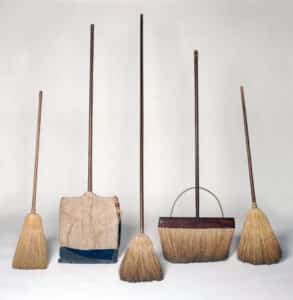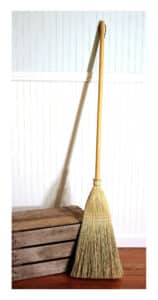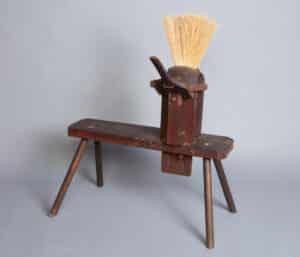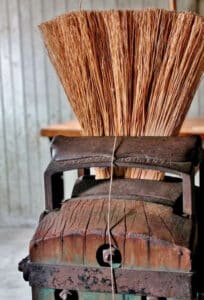by Jessica Kosinski

If you are looking for furniture that is as useful as it is beautiful, Shaker furniture is near the top of the list. The Shakers were a religious group, but they also formed their own society with distinct values. They wanted to be as self-sufficient within that society as possible, so they developed their own approach to making their own furnishings and household items. They were particularly known for creating specific types of brushes and brooms. In fact, Shaker brooms forever changed broom functionality and construction. Let’s take a peek at why Shaker brooms and brushes are just as sought after as the group’s many other tools and pieces of furniture still today.
A Brief History of Shakers
To understand the origins of the Shakers, we must go back to the Quakers. Also known as “The Brotherhood of Friends” or “Religious Society of Friends,” the Quakers were formed in the 17th century in Lancashire, England. They were Christians in a specific religious group known for “trembling before God.” The congregation physically shook and trembled during services. That led to the nickname “Quakers,” which is the more popular name today. However, it has never been the official name of the group.
The Shakers were formed in England in 1740 when worship practices changed for most other Quakers. The small Shaker group maintained the original style of worship. That led them to be known as “Shakers.” James and Jane Wardley led the Shaker congregation in England. A member of their congregation named Ann Lee and her family brought Shaker practices to the United States soon after. They settled in 1776 near Albany, New York.
Shaker Separatism
The American Shakers tried to strike an odd balance between maintaining their numbers and not violating their beliefs. Specifically, Shakers did not believe in having their own children. They sometimes adopted children or tried to convert adults into Shakers. Shaker beliefs included living communally apart from regular society, much like the Amish. However, they still had to conduct certain business with other settlers.
As part of separating themselves as much as possible from non-Shakers, the Shaker people developed their own ways of doing things. That included building their own furniture and creating other utilitarian tools. For example, they were known for their unique style of basket making at one point in time. However, aside from furniture, they were most known for their impact on the evolution of the broom.
Early Broom Development

There is no known date for the invention of the broom. Some version of it has existed since ancient times. What is known is that many civilizations relied upon the same basic form of broom construction until the late 1700s. Almost all early brooms consisted of long handles with some sort of bristle-like attachments. Those attachments included twigs, corn husks, hay, and straw. Each of those brooms typically had bristles that fanned out in a round formation.
How a Farmer and New Technology Changed American Brooms
In 1797, a farmer named Levi Dickenson was living with his wife in Hadley, Massachusetts. He made her a broom using a certain type of grain called sorghum vulgere. Mrs. Dickenson loved the broom so much that she told as many people as possible about it. Soon, everyone wanted brooms made from the same grain. That grain was later christened “broom corn.”
Early brooms still had one key problem. They fell apart fairly quickly. It was evident to Levi that his brooms were superior in terms of materials, but the traditional broom construction was still inferior. That changed in 1810 when some clever inventors created the machine known as the Broom Vise for making brooms and a better method for securing the bristles to the handle.
How the Shakers Forever Changed Brooms Again

photo: Shaker Museum

The Shakers saw the wisdom of securing bristles to brushes better to make their brooms last longer. However, they created a new way to do so. They used wire, rather than wooden pegs used previously.
The Shakers also felt the round design of the broom bristles that had lasted for centuries was long overdue for an update. They used a vise to flatten each of their brooms. The new flat design made the brooms far more efficient and easier to use. They also carried over many of their novel ideas into the construction of high-quality brushes of various sorts.
Popular Types of Shaker Brooms and Brushes
Traditional flat brooms are still among the most popular Shaker or Shaker-style brooms and brushes to collect. However, Shaker hand-held whisk brooms are also quite popular. The creation of flat whisk brooms changed the way people cleaned their homes forever. Shorter broom handles allowed them to clean in places that were otherwise hard to access with very little effort. Today, whisk brooms are still popular tools in homes. Antique Shaker whisk brooms are still used in some homes.
These brooms are more often collected for display purposes. Their small sizes make them perfect wall decorations.

The Shakers were also known for making many different types of brushes, which are still collected today. Barber brushes and clothes brushes are among the most popular. Most such shaker brushes had horsehair bristles. The shakers also made many other brushes designed for specific purposes, such as paintbrushes. However, some Shaker brushes were designed as multi-use tools. Those wood-handled brushes were built with sturdy construction methods so they could stand up to long periods of use.
Collecting Shaker or Shaker-Style Brooms and Brushes
Collecting truly antique shaker brooms and brushes is not easy. Many that can be authenticated are in the hands of regular museums or living museums. Shaker brooms and brushes that have survived and are not in museum hands are often difficult to authenticate. That is because such Shaker-style items were so useful and popular that production of them has never stopped.
If you are interested in decorating your home, Shaker-style pieces may serve your needs while staying within your budget. They are also quite easy to find. In fact, many craftspeople still go out of their way to use the old Shaker methods today. They include several American craftspeople living near the area where the Shakers first settled in New York.





Related posts: